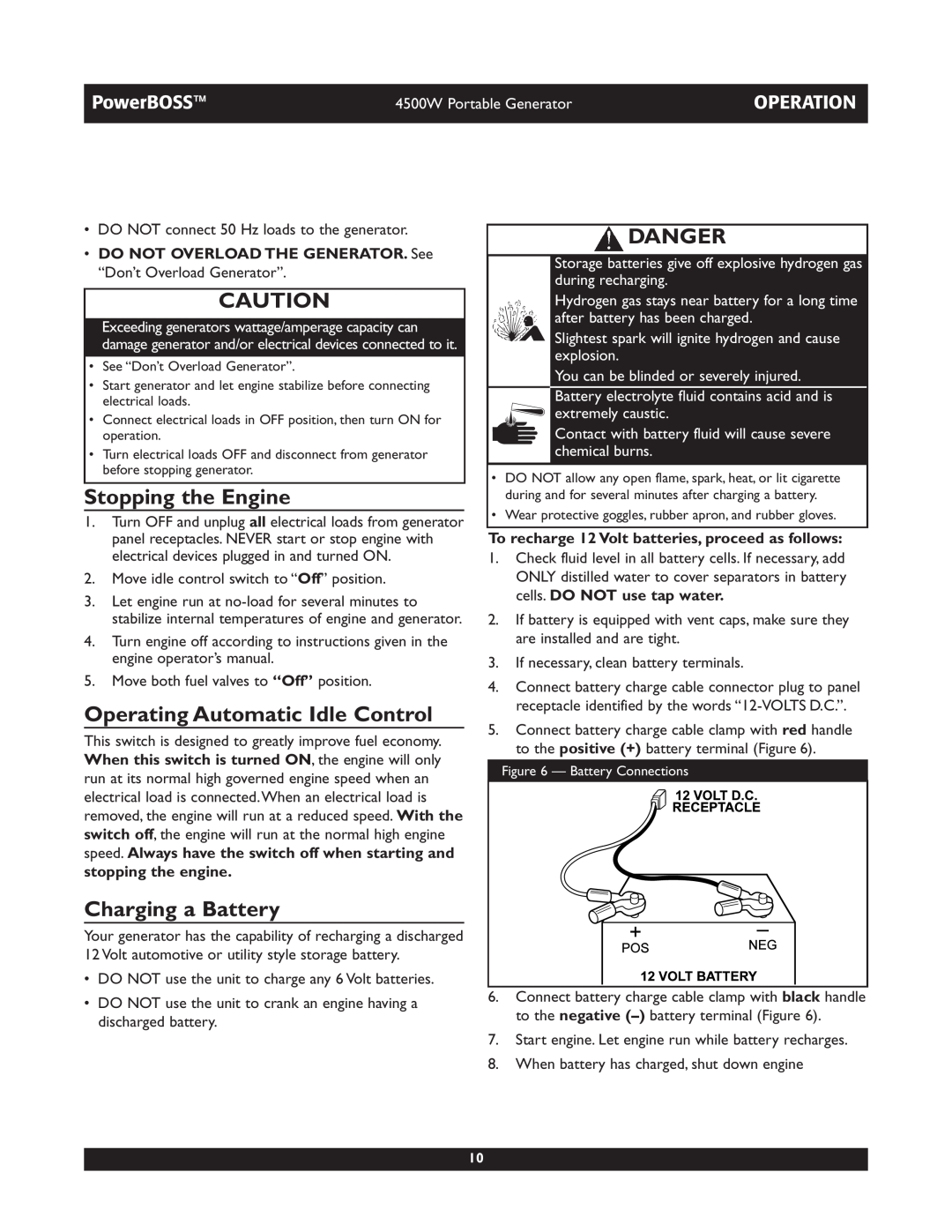BRIGGS & STRATTON POWER PRODUCTS GROUP, LLC
Model / Modelo 01648-1 4500W
ADVERTENCIA
Operator’s Manual Manual del Operario
Hazard Symbols and Meanings
TABLE OF CONTENTS
SAFETY RULES
PowerBOSS
Contact with battery fluid will cause severe chemical burns
SAFETY RULES
Battery electrolyte fluid contains acid and is extremely caustic
Generator produces powerful voltage
Unintentional sparking can result in fire or electric shock
Broken bones, fractures, bruises or sprains could result
Severe burns can occur on contact
Excessively low speeds impose a heavy load
Oil Fill 120/240 Volt AC 30 Amp Receptacle Idle Control Switch
FEATURES AND CONTROLS
KNOW YOUR GENERATOR
Recoil Starter Fuel Valve Air Cleaner Choke Lever
ASSEMBLY
ASSEMBLY
Install Wheel Kit
Unpacking the Generator
Add Engine Oil
BEFORE STARTING THE ENGINE
Add Fuel
System Ground
USING THE GENERATOR
Connecting to a Building’s Electrical System
Generator Location
GENERATOR
Connecting Electrical Loads
OPERATING THE
Starting the Engine
Stopping the Engine
Charging a Battery
Operating Automatic Idle Control
120 Volt AC, 20 Amp, GFCI Duplex Receptacles
RECEPTACLES
120/240 Volt AC, 30 Amp, Locking Receptacle
12 Volt DC, 10 Amp Receptacle
Testing the GFCI
Ground Fault Protection
Generator produces hazardous voltage/current
Creating a Temporary Cold Weather Shelter
COLD WEATHER OPERATION
Creating a Permanent Cold Weather Shelter
DONT OVERLOAD GENERATOR
Power Management
Capacity
Engine Maintenance
SPECIFICATIONS
GENERAL MAINTENANCE RECOMMENDATIONS
Maintenance Minder
Generator Storage
Generator Cleaning
STORAGE
Other Storage Tips
Problem
TROUBLESHOOTING
TROUBLESHOOTING
Cause
PowerBOSS
2 years
BRIGGS & STRATTON POWER PRODUCTS GROUP, LLC JEFFERSON, WI, USA
Consumer Use
Commercial Use
DESCRIPCIÓN DEL EQUIPO
CONSERVE ESTAS INSTRUCCIONES
TABLA DE CONTENIDOS
REGLAS DE SEGURIDAD
Una pequeña chispa puede encender el hidrógeno y causar una explosión
PELIGRO
REGLAS DE SEGURIDAD
Usted puede quedar ciego o sufrir heridas muy graves
Quemaduras severas pueden ocurrir al hacer contacto
PRECAUCIÓN
Como resultado, podrían producirse fracturas, contusiones o esguinces
CUANDO AJUSTE O HAGA REPARACIONES A SU GENERADOR
CONOZCA SU GENERADOR
POWERBOSS
CARACTERÍSTICAS Y CONTROLES
Desembalaje del Generador
MONTAJE
MONTAJE
Instale el Juego de Ruedas
Agregue Combustible
ANTES DE DARLE ARRANQUE AL MOTOR
Agregar Aceite al Motor
CUANDO AÑADA COMBUSTIBLE
Tierra del Sistema
USO DEL GENERADOR
OPERACIÓN
Conexión al Sistema Eléctrico de un Edificio
Conexion De Cargas Electricas
OPERANDO EL GENERADOR
Encienda el Motor
Figura 15 - Válvulas de Combustible
Carga de la Bateria
Parado Del Motor
Funcionamiento del Control Automatico de Marcha en Vacio
NO SOBRECARGUE EL GENERADOR.Vea No Sobrecargue Generador
120 Volt AC, 20 Amp, GFCI Receptáculos Dobles
RECEPTÁCULOS PRECAUCIÓN
120/240 Voltios AC, 30 Amp, Receptáculo de Seguridad
Tomacorrientes de 12 Voltios DC
Comprobación del GFCI
Protección Contra Fallos de Conexión a Tierra
El generador produce niveles de tensión/corriente peligrosos
Creación de una Clima Frío Estructura de Protección Permanente
OPERACIÓN DURANTE UN CLIMA FRÍO
Creación de una Clima Frío Estructura de Protección Provisional
Figura 21 - Clima Frío Estructura de Protección
Control de la Energía
NO SOBRECARGUE GENERADOR
Capacidad
Ejemplo
MANTENIMIENTO
ESPECIFICACIONES
RECOMENDACIONES GENERALES DE MANTENIMIENTO
Mantenimiento del Motor
Para Limpiar el Generador
ALMACENAMIENTO
ALMACENAMIENTO
Almacenando el Generador
El motor está funcionando pero no
DIAGNOSITICOS DE AVERÍAS
DIAGNOSITICOS DE AVERÍAS
existe salida de AC disponsible
Uso del consumidor
BRIGGS & STRATTON POWER PRODUCTS GROUP, LLC JEFFERSON, WI, EE.UU
BRIGGS & STRATTON POWER PRODUCTS GROUP, LLC
Uso comercial
